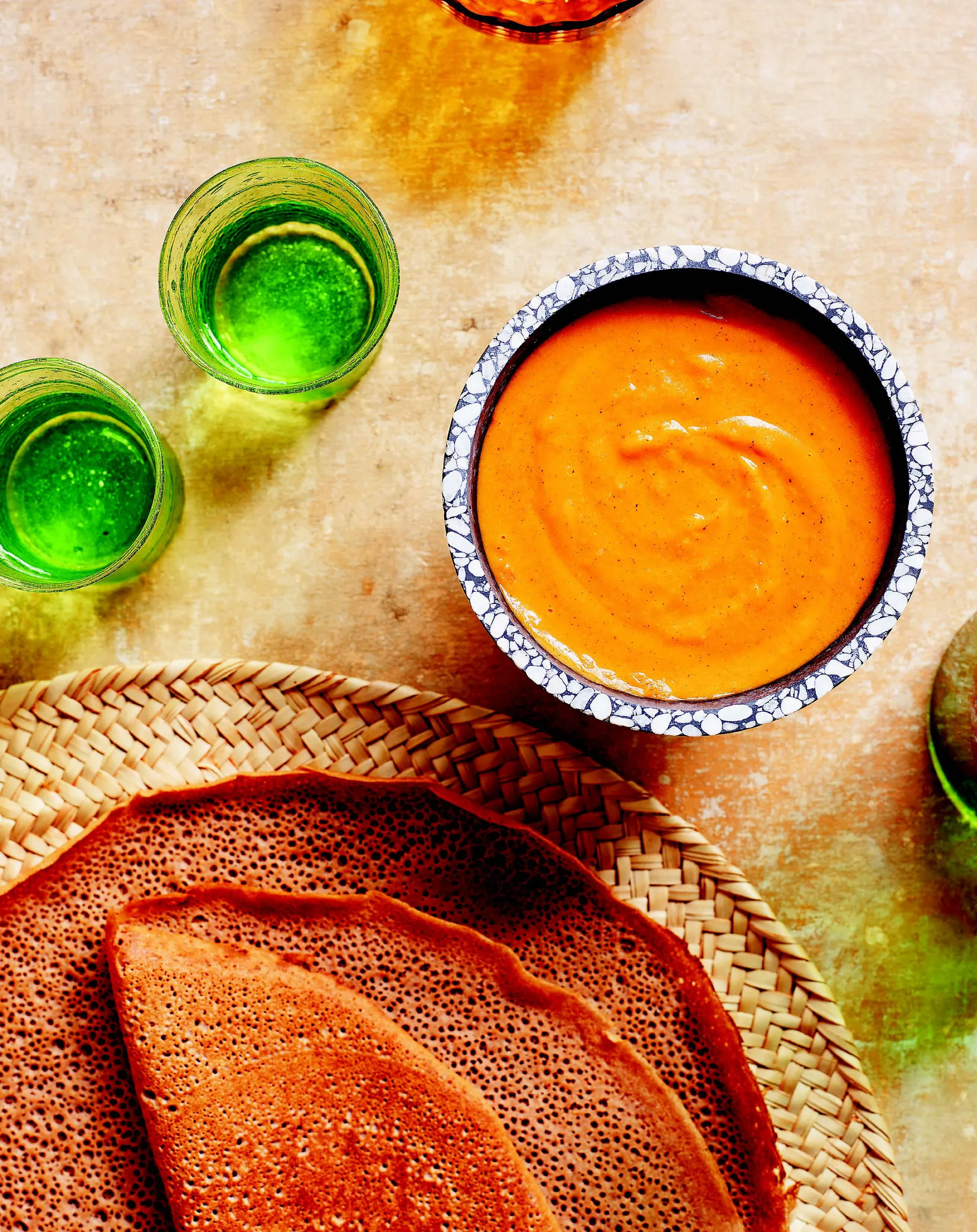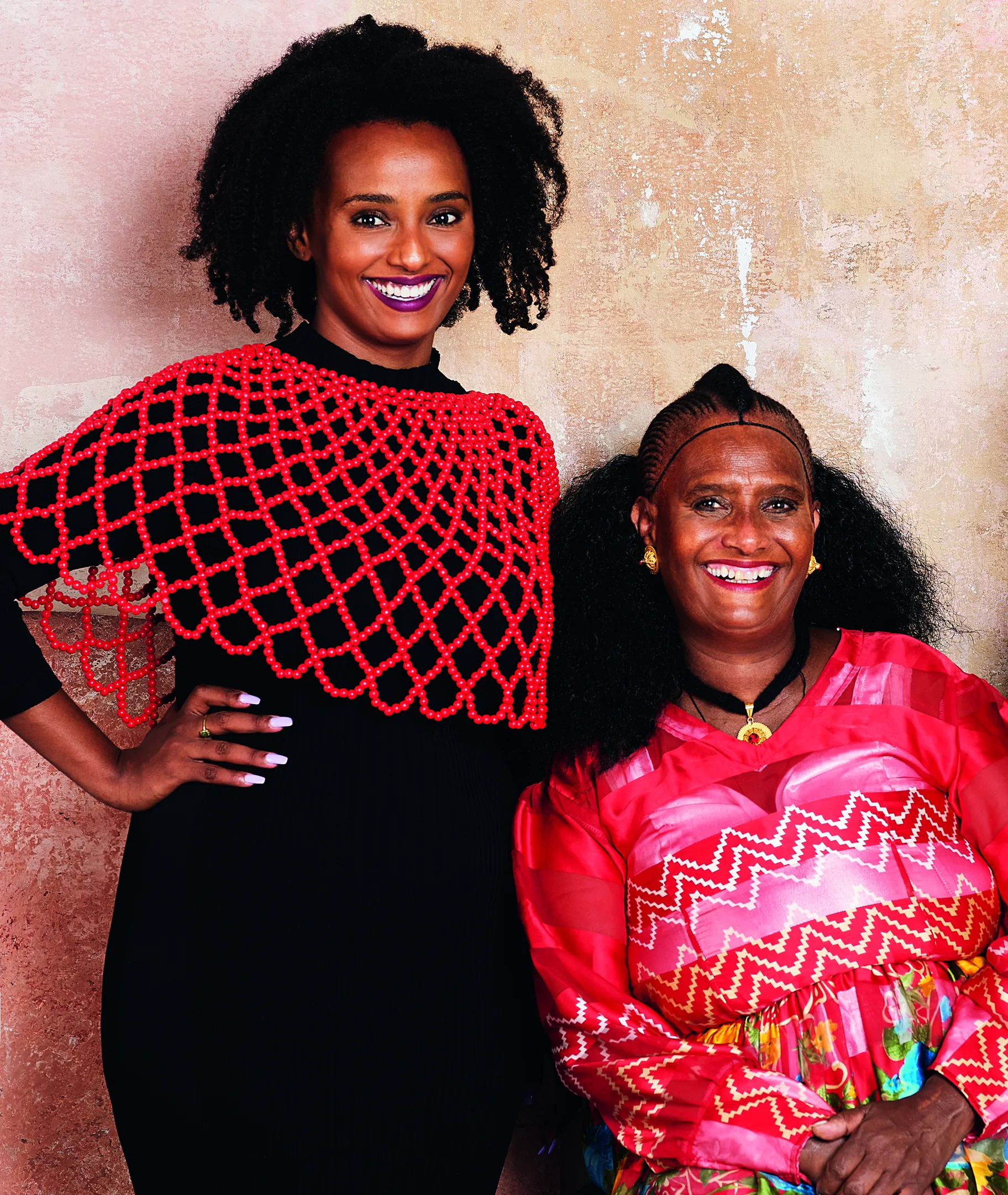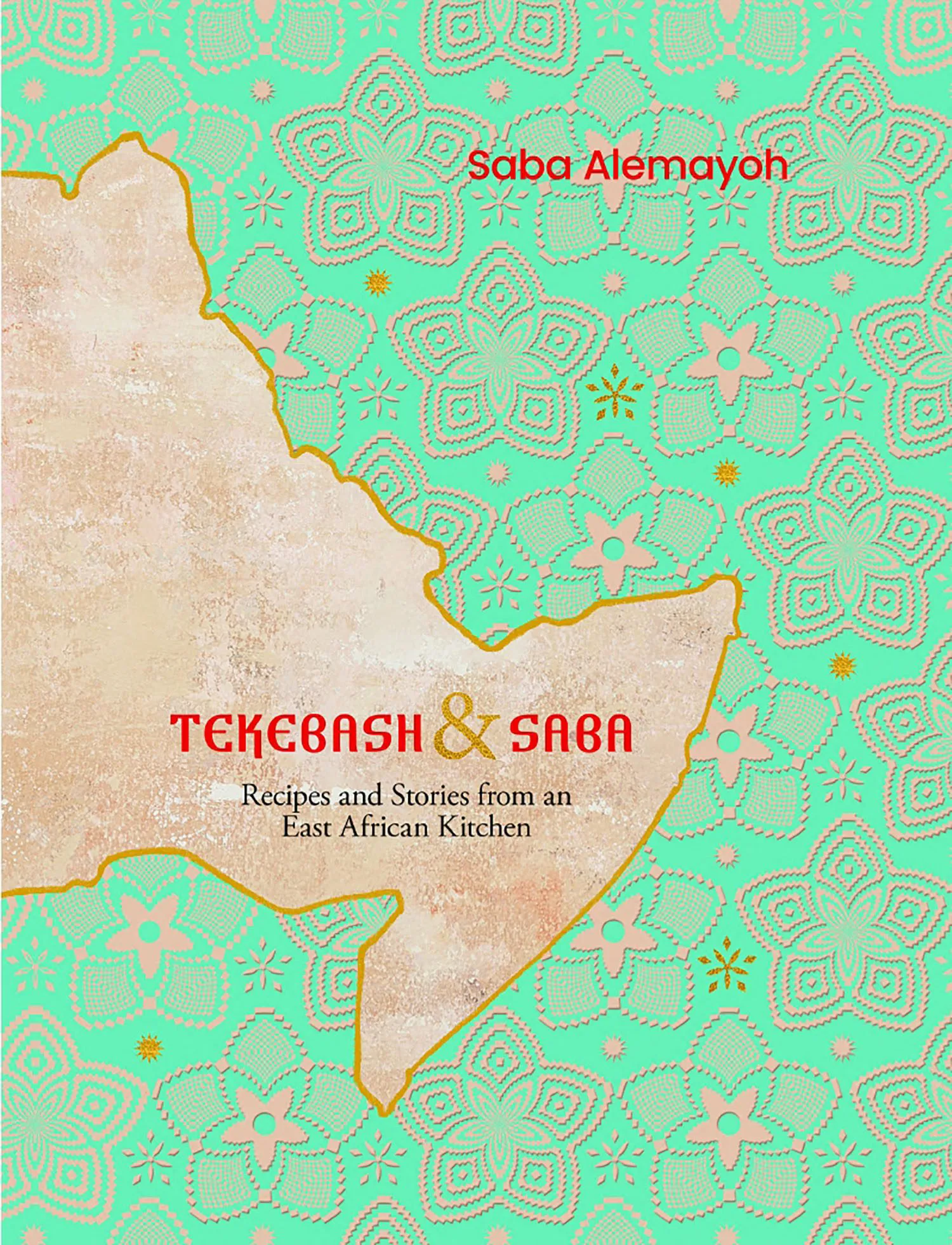Sometimes cookbooks communicate flavors and techniques in a straightforward way. Tekebash & Saba: Recipes and Stories from an East African Kitchen is not that kind of book. Written by Saba Alemayoh, it's an extraordinary document of a daughter's love for her mother.
Born in Tigray, a remote, mountainous region in Northern Ethiopia, Tekebash Gebre was only 17 when she left the country to escape its civil war. She settled in Sudan, where she found a community of fellow Tigray refugees. That's where Saba was born. When Saba was 9 years old, Tekebash brought both of them to Australia. In 2015, Saba opened Saba in Melbourne, where she worked front of house while Tekebash prepared the food. The restaurant closed in September 2020.
Saba takes us through the complexity of her mother's story, which includes civil war, migration, divorce and emigration, all of it emotionally bound up with Tigray culture and food.
Evan Kleiman: In the book, you say that the concept of being Ethiopian is a constructed one. You paraphrase author Chimamanda Ngozi Adichie, who says, "The only authentic identity for the African is the tribe. We became Ethiopian through conquests." So tell us a bit about where Tigray is and how the culture is different from the rest of Ethiopia.
Saba Alemayoh: I don't want to over emphasize… the differences because there are some similarities in the same way that Americans might have a lot of similarities with Canadians or, in Switzerland, the ones who share a border with Germany might have a lot of similarities to Germans on the other side. Tigray is located in the northern regions of Ethiopia, so it's in the furthest north bordering Eritrea. The Eritreans from the south are also from the same actual tribe as Tigaru but obviously there's a border now so half of us identify as Ethiopian Tigaru and the other ones are from Eritrea. There's that distinction but what was really important and different that can be highlighted between Tigaru and the rest of Ethiopia is historical context.
Tigray used to be the capital city back in the days of Abyssinia and the ancient Aksumite Kingdom also comes from that area. So when we talk about the Queen of Sheba, her birthplace is Aksum, which is in the heart of Tigray, and that dynasty went all the way up to Yemen. Historically, there's that context. Religiously, Ethiopia in general is about 40% Muslim and 60% Christian. Most of the Christians are Orthodox Christians. However, in Tigray, you get 98% Orthodox Christians and only 2% of other denominations, whether it be Catholics or Muslims. That plays a role in the culinary experience, that plays a role in the cultural experience.
Orthodox Christians, generally speaking, do Lent about 200+ days of the year, in which they go vegan. That heavily influences the cuisine that you're getting. Also in Tigray, the land is a little bit drier and a lot more mountainous. That changes the cuisine in terms of what people have access to and what they're eating. You see a lot more heavy, legume-based produce that can last the test of time. Chickpeas and things like that, they will ground that up and they can last you the year without having to worry about it. We don't have any water. It's completely landlocked. As a result, it doesn't have fish dishes that are the basis of Tigray cuisine. Also, you see that teff grains are a bit more readily grown within the North. As a result, the staple is very heavily injera.

Shiro powder is used to make a sauce that's similar to bechamel and can be transformed into a stew. Photo by Alicia Taylor.
The book is such an unusual document in terms of documenting your mother, Tekebash, who lived through some pretty dramatic times. Her life was sort of outlined by external conflict and an ebb and flow from one country to another. Could you tell us a little bit about her and about living in Sudan as a part of the Tigray community?
Even though this story uses my mother as the main protagonist, unfortunately or fortunately, it's a very common story. My mother wasn't the only one who escaped through that route when she left during the civil war between the communist government. When she left, there were hordes of these young people who had been leaving in droves from Tigray. So there was an influx of these 17, 18, 19-year-olds and young people who found themselves in a strange city.
Culturally, it was a really shocking city to be in because it practiced Sharia law. Most of them had never been exposed to anyone outside of Tigray. They were very sheltered. Kids is what I would call them who, all of a sudden, found themselves in a new city, not by choice. They were struggling a lot culturally with what was going on in that city, whether it be the Sharia laws that they were experiencing or the lack of familial support. And given that it was such a communal society, all of a sudden they were dislodged.
Your mom is 17, she finds herself in Khartoum. Very soon after arriving, she becomes a housemaid in a Sudanese household and she's expected to cook. But she had never cooked before. It's fascinating to me that the woman who ended up being your touchstone for Tigray culture through her cuisine, first starts to cook a type of food that is not her own.
Yes, my mum was in a slightly different position in that she was the youngest in her household. Normally, by her age, she should have learned to cook most of the Tigrayan dishes. But she was the youngest of the house and by the time she was born, her brothers had already been married. Therefore, there were sister-in-laws in the house who were already taking on the domestic duties. So she learned initially to cook Sudanese food. That was generally the job that most Tigray refugees did — housemaids, cleaners, gatemen, and sometimes drivers — for Sudanese households.
When she was doing that, she got taught that. After that, every time they wanted to cook on their days off, all the younger [Tigray] women would go to the older [Tigray] women, asking them how to make this, how to make that. The older women that were there would be teaching them. She didn't have the privilege of learning it through her mother or her older sisters, which would have been the natural progression, but rather from all these older women mentors, in Khartoum, who were taking on the younger females as their own or as younger siblings or daughters, depending on how old they were.
Are there any recipes in the book that are from this time of your mother's life that integrate Sudanese ideas into the Tigrayan?

Saba Alemayoh (left) says her mother's story of fleeing Ethiopia during the civil war is all too common. Photo by Alicia Taylor.
Yeah, so the okra and lamb dish, the bamya, is purely a Sudanese dish. It's not a dish eaten at all in Tigray. In fact, I think when you cook it for Tigray people, they find the slimy nature of okra a little bit uncomfortable, usually when they're not exposed. What they do is they end up doing it with a twist of Tigrayan spice, adding specific types of chilies and so on. Sudanese cuisine, generally speaking, doesn't really use a lot of chili and a lot of spicy flavors. It tends to mimic a bit more that Middle Eastern style of cuisine, so [you see] a lot of the cumins but not so much chili and pepper.
When it comes to Tigrayan cuisine, what is its backbone?
Its backbone, to be honest, is three very key ingredients. One is berbere or dilik. To call it chili is to simplify it too much because it's got about 15 to 20 spices in it. They dry up some chili, some garlic, some cumin — you roast some of this stuff, as well, before you dry it up — some ginger. They've got multiple spices in it. Each household has their own combination of the spices and they take it to the local mill and they grind it up. When you look at berbere, you might see, "Oh, is this just chili powder?" But it's not chili powder because it's infused with a lot of flavors and a lot of spices to make it like a perfect blend.
Another key element that you'll see is tesmi, which is spiced butter. It's butter but they put all these spices in it and then they drain all the spices away and then allow it to solidify so it becomes this spiced ghee that you can use for dishes.
Another key ingredient is teff, which is the grain that we use. So the simple grain that they talk about, one of the ancient grains, this teff is used as the staple starch of all of our food. We ferment it, like a sourdough bread mix, and we make a flatbread with it and that becomes the utensil/your starch to eat every single thing with.
You call chickpeas a superstar of the Tigray kitchen. How are they used? It's quite an unusual way.
To make the powder, they will roast chickpeas, they will add berbere to it, they will then add onions. So almost everything is already balanced with it, then they grind it up. What you end up with is an orange-looking powder. That powder, if it's already not started well, if it is not correct already, no matter how you cook that shiro dish, it will always be off. So that powder mixture has to be perfectly on point. Also, because of lack of refrigeration, that powder tends to last for years and this is what families use. It will always be in the house, every household will always have that.
If you're out of groceries, I guess an Australian household would have baked beans on toast or a quick spaghetti for Italians. It's that for us. If there's nothing in the house, your mother will find that and that is what she will cook. But it's still considered something quite delicious and something that we like. Even when there is something, people can say, "Oh, I want shiro today."
How is it prepared? How is this seasoned chickpea flour transformed?
Like bechamel sauce would be the way I would describe it. Then after that, you've got the chickpea powder. Again, we love onions in everything. Then you do your sauteeing of your onions and so on. You might put a little bit more salt in. Then you put water in it. You boil the water and so it doesn't clump up. Just like bechamel sauce, you would then put little bits, little bits, little bits of the powder while you're still whisking it to ensure that you get this consistency. The consistency of it, or how Western people will refer to it, is like soup. But for us, we don't use it as soup. We use it as a dip that we eat injera with.
Yeah, it's almost like a porridge.
Yeah, it's like that. But you definitely have to whisk it a lot to insure that it doesn't clump up.
Shiro Powder And Shiro Stew
Spiced chickpea powder and chickpea stew
Makes 10 cups (1.25 kg) powder / Stew serves 2
The average Tigraweyti family would have shiro daily: it was cheap and accessible. However, the flavors within it are nothing to snub your nose over—it’s absolutely delicious. In the eighties and nineties, Tigray and Ethiopia as a whole was devastated by the HIV epidemic and there were advertisements everywhere for condoms and the prevention of HIV. Most older folks had no grasp on what it was, but all were scared of the devastating effects.
One day my cousin asked my aunt what’s for lunch today and she said “shiro” and he said to her, “I don’t know if you’ve heard, but they are saying shiro can give you HIV” and she didn’t miss a beat and responded, “Well, we will have to eat it with a condom because shiro is not negotiable.” This is how strongly we feel about shiro! To be frank, I don’t believe she or the community really understood what HIV was or how it was transmitted, since literacy levels were quite low and the conservative nature of the culture prevents open discussion about sex education.
This recipe makes a very generous amount, but given it takes several steps to make, it’s worth making a big batch to enjoy over time. If you’d prefer to make a smaller amount, feel free to divide the quantities.
Ingredients
For the Shiro powder
- 2½ cups (500 g) chickpeas, dried and peeled
- 2¼ cups (500 g) peeled yellow split peas
- 5½ oz (150 g) dried chiles
- 2 tablespoons (25 g) dried garlic powder
- ¼ cup (25 g) ground ginger
- 2½ tablespoons (25 g) dried onion
- 2 tablespoons (35 g) coarse sea salt
- scant ½ cup (10 g) dried basil
- heaped 1 tablespoon (12 g) cardamom seeds
- heaped 1 tablespoon (12 g) rue seeds
For the Shiro stew
- ½ onion, diced
- 1 teaspoon minced garlic
- sunflower oil, for cooking
- ½ teaspoon salt
- 1 cup (120 g) Shiro powder (see above)
- Injera (page 21), to serve
Instructions
-
For the shiro powder, roast the chickpeas and yellow split peas in a large, dry nonstick frying pan for 10–15 minutes, or until a nice golden brown color. Set aside.
-
Separately, roast the spices for 1–2 minutes in a dry frying pan.
-
After all the spices have cooled, mix everything together in a big bowl. Use a food processor to grind the mixture in batches to a smooth flour consistency.
-
When the whole mixture has been ground, transfer to an airtight container. At room temperature, it can be stored for 4–5 months. If stored in the freezer, it can last up to 1 year.
-
To make shiro stew, sauté the onion and garlic in oil in a small saucepan. Use just enough oil to keep the onion from sticking.
-
Once translucent, add 2½ cups (625 ml) water and the salt to the pan and bring to a boil. Slowly add the shiro powder and use a whisk to keep it nice and smooth. Once you have mixed the shiro powder enough that there are no lumps, reduce the heat to medium, put the lid on, and let it cook for another 10 minutes. The mixture will get thicker as you keep it on the stove. It has a tendency to pop everywhere, so placing a lid on the pan will be a good idea.

"Tekebash & Saba: Recipes and Stories from an East African Kitchen" is a daughter's retelling of her mother's journey from Tigray to Australia. Photo courtesy of Interlink Books.
